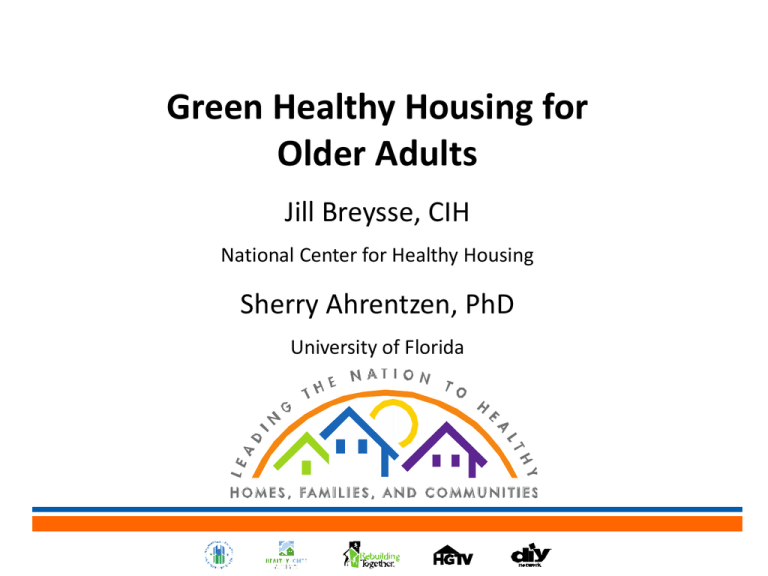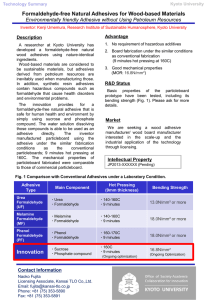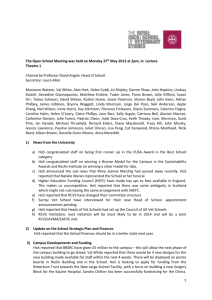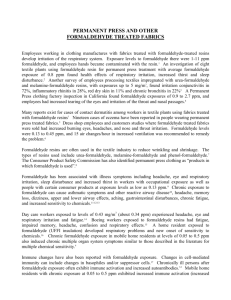Presentation 1 - National Healthy Homes Conference
advertisement

Green Healthy Housing for Older Adults Jill Breysse, CIH National Center for Healthy Housing Sherry Ahrentzen, PhD University of Florida By 2030, more than 70 million Americans – and 960 million people worldwide – will be 65 years or older Seniors Susceptible to Housing Conditions • Many older adults spend 80% to 90% time indoors at home • Bronchial hyper-responsiveness, respiratory, diabetes • More likely to live in older homes • Arthritis, osteoporosis, muscular atrophy, visual impairments • With older heating/cooling systems • Thermal stress, lower activity and metabolic rate, visual impairments • Older homes can be damp, noisy, stuffy, dark • Anxiety, depression, 11.2 million seniors living alone in 2008 • Homes built prior to ADA, Fair Housing, or visitability legislation • Physical, sensory and cognitive disabilities • Majority live in auto-dependent suburbs • Limited mobility, diverse population with diverse housing needs • More likely to engage in pro-environmental behaviors, purchases • Depression-era frugality, practices, familiarity, consumption values Is Green Housing Healthy Housing for Seniors? Two Retrofit Case Studies GREAT Study: Mankato MN GAP Study: Phoenix AZ • Cold Climate (Zone 6) • 7-story, circa 1970s • Public housing, primarily seniors and disabled • Retrofit to Enterprise Green Communities & LEED • Lengthy construction (~2 yrs) • Environ. monitoring, health interviews, VA, bldg performance • HOS-based interview • Panel study, pre- and post- • Hot, Arid Climate (Zone 2) • 3-story, circa 1970s • Project-based Section 8, seniors only • Retrofit to ARRA Green Retrofit Program • Short construction (~6 mos) • Environ. monitoring, health interviews, bldg performance, environ. perceptions • NHIS-, BRFSS-based interview • Panel study, pre- and post- Health Outcomes Among Primarily Elderly Residents Associated with Green-Renovated Public Housing Study Team Orness photo: Blumentals Architects Research Goals Baseline to 1-year post: • Resident physical and mental health change • If health declined, resident health declined less than that of general MN population • Improvements in temperature, RH, CO2, allergens, total volatile organic chemicals (TVOC), & formaldehyde levels • Decrease in # of housing condition deficiencies PRE-RENOVATION Source: Blumental Architects GREEN POST-RENOVATION RENOVATION Source: Blumental Architects Methodology • Health Interview: – Physical &Mental Health: Medicare Health Outcomes Survey (HOS) • VR-12 Health Survey Physical Component Score (PCS) & Mental Component Score (MCS) • Limitations in Activities of Daily Living (ADL) – Housing condition • Visual Assessment • Environmental Monitoring and Sampling • Building Performance Testing 11 Study and Comparison Groups Study Group: • Baseline: 53+19=72 residents in two stages • 1-Yr Post: 40 of 49 baseline participants • 2 study groups: All Ages (33-86 yrs; n=40) & Elder (65-86 yrs; n=22) Comparison Group: Medicare HOS: HOS All Ages group (n=40); HOS Elder group (n=572) Study Group Baseline Demographics (n=40) • Median age 66 years • 70% female • 95% non-Hispanic White • 92% had incomes <$20,000 • 82% high school or college 13 All Ages: Mental Health Outcomes Study Group Change HOS Group Change Study vs HOS Mean # of good days 1.6 (p=0.066)* -1.5 (p=0.167) p=0.026** Mean VR-12 MCS 1.9 (p=0.159) -2.8 (p=0.071)* p=.023** Outcome 14 *marginally significant and **significant at p<0.05 All Ages: Physical Health Outcomes Outcome % who fell in past year % in fair or poor health % with ≥1 ADL limitation Mean VR-12 PCS Mean # of good days Study Group HOS Group Study vs. Change Change HOS -16% (p=0.134) -8% (p=0.317) 28% (p=0.002)** -1.1 (p=0.578) 1.4 (p=0.366) 8% (p=0.257) 2% (p=0.705) 13% (p=0.096)* -0.3 (p=0.797) 0.7 (p=0.546) p=0.055* p=0.314 p=0.196 p=0.737 p=0.704 *marginally significant and **significant at p<0.05 ELDER: Physical Health Outcomes Outcome % who fell in past year % in fair or poor health % with ≥1 ADL limitation Mean VR-12 PCS Mean # of good days Study Group HOS Group Change Change -5% (p=0.739) -9% (p=0.317) 32% (p=0.008)** -2.1 (p=0.503) 0.9 (p=0.729) 0% (p=1.000) 6% (p<0.001)** 4% (p=0.024)** -0.7 (p=0.064)* -0.7 (p=0.099)* Study vs HOS p=0.742 p=0.094* p=0.021** p=0.669 p=0.526 *marginally significant and **significant at p<0.05 Housing Condition Tobacco Smoke: -20%** Water/Dampness: -30%** Insecticide Use: -38%** Kitchen Fan Use: 0.6** Bathroom Fan Use: 2.9** **significant at p<0.05 Environmental Monitoring and Sampling • Dewpoint: Connection between indoor and outdoor • CO2 levels significantly improved • No significant change in TVOC, formaldehyde, most allergens 18 Building Performance • Fresh Air Ventilation: 1-BR: 53 cfm (ASHRAE 20 cfm) • Bathroom Exhaust Testing: 29 cfm (ASHRAE 25 cfm) • Pressure Balance: minimal deviations from design • Energy Use: 44% reduction 19 Conclusions • • • • • Greatly improved building, esp. HVAC system Improved mental health Improved general physical health Fewer falls Substantially less indoor smoking 20 Green Apple Project [GAP] Phoenix, AZ Green Apple Project Research Team Sunnyslope Manor — Phoenix After a green retrofit of assisted housing development for low-income older adults… • IEQ will show sustained improvement although it may be worse immediately • If IEQ improves, residents will perceive this change • Environmental and IEQ improvements will correlate with corresponding changes in resident health, behavior and attitudes • Retrofit changes may result in healthcare cost savings, for falls prevention Research Methodology • Panel Study: O X O O • Data Collection Periods P1: June-July 2010 X: Feb – July 2011 P2: April – Sep 2011 P3: June – Aug 2012 • Sample Size — P1: 77 residents in 73 units — P1 + P2: 59 residents in 55 units — P1 + P3: 57 residents in 53 units • Proxy + Threshold Measures Major Renovations • PTAC system updated • Energy Star exhaust fans, appliances • New bedroom ceiling fan • Double-pane, low-E sliding balcony door and window • Low-flow plumbing fixtures • New roof primer, insulation • Complete kitchen remodel and bathroom remodel with low-VOC materials • Low-VOC flooring, paint, adhesives Resident Characteristics • 74% women, 26% men • Average age: 73 (range 62 to 92) • Race/ethnicity: 83% White, 5% Native American, 4% African American, 2% Asian American, 14% Latino • 21% smoke • 88% live alone • 65% report at least 1 respiratory problem • # days in last 30 that physical health not good (at P1): 3 (median) • Emotional distress significantly higher than national sample (NHIS) of low-income older adults IEQ Data Collection • • • • • • • Temperature RH CFM50 Particulate Matter Formaldehyde Acetone Acetaldehyde Health Data Collection (NHIS, BFRSS/Arizona) • • • • • • Quality of Health/Life Respiratory-related Emotional distress Sleep Functional activities Falls also • Comfort/satisfaction of lighting, thermal, air quality, humidity • Household cleaning frequency, products Panel (Fixed-Effects) Regression Analyses “Scorecard” Immediate Outcomes Sustaining Outcomes • • • • • • • Temperature RH Air Infiltration Particulate Matter Formaldehyde Acetone Acetaldehyde • • • • • • • Temperature (min, max, extremes, var) RH (variability) Air Infiltration Particulate Matter (for smokers) Formaldehyde Acetone (i/o only) Acetaldehyde • • • • • • • Overall Quality of Health/Life Respiratory Emotional Distress Sleep Functional Limitations, Falls IEQ Perceptions Cleaning Behaviors19 • • • • • • • • Overall Quality of Health/Life Respiratory Emotional Distress (improve) Sleep Functional Limitations, Falls IEQ Perceptions Cleaning Behaviors + Booklet Use Falls Risk Cost Threshold Exceeded 1. Major Finding: Extreme Temperature Reductions Overall across panels, a noticeable reduction in extreme indoor temperatures Count = # of times of 448 data points that Indoor temperature exceeded 81º in Units Extreme Temperature Reductions in Units (cont.) Within a resident’s apartment, significant reductions in number of instances of extreme indoor temperatures from baseline to post-retrofit panels Extreme Temperature Reductions in Units (cont.) Significant Regression of Exceed 81 Changes on correspondence Reported Health Changes, for P1P3 between a unit’s sustained (P1P3) Quality of Emotional Health/Life Distress reduction in extreme temperature AND t m t p value improvements in resident’s reported Exceed 81 3.179 .002 -2.085 .039 quality of health/life, emotional distress and sleep # Hours Sleep t p value 2.150 .034 2. Major Finding: Formaldehyde Reduction Material choices (i.e. low VOC sealants and paint) had greatest impact on decreased formaldehyde. Astoundingly high levels of FA found in Panels 1 and 2; decreased in every unit in the long term. Initial elevation can be expected for installation of new carpeting or cabinetry. 3. Major Finding: Reduced Emotional Distress Associated with Changes in Environmental Perceptions Following Retrofit • Physiological Changes – Quality of life/health – Functional activities • Environmental Changes – Long-term reductions in extreme temperature in unit – Short-term (and marginally long term) reductions in formaldehyde concentrations – Long-term reduction after construction • Environmental Contribution (+P2, -P3) • Resident Perceptions of Environmental Quality (P3) – Satisfaction kitchen lighting – Satisfaction kitchen temperature – Satisfaction kitchen air quality – Lighting enhances comfort – Satisfaction with visual comfort Quality of Functional Kitchen Life Activities Light Kitchen Kitchen Light Visual Temp Air Quality Enhances comfort 0 -0.1 -0.2 -0.3 -0.4 -0.5 -0.6 Panel 1 Panel 3 Level of significance 4. Major Finding: Expected Reductions in Health Care Costs of Falls Approximate Target Renovation Costs Falls Post Renovation: Baseline rate of injuries over 15 years: 330 falls, of which 105 would require medical care After 3 months: 52% reduction After one year: 6% reduction $$$ At 6% reduction, savings in health care costs ($266,000) approximate cost of selected renovations ($286,000) for: • • • Improved lighting Improvements in floor treatments Improvements in stairway hand rails Take-Home Lessons • Both studies: Green renovation can have positive impact on mental health and fall prevention • GAP: Green renovation may reduce exposure to contaminants, and some health improvements may be tied to changes in environmental quality • GREAT: No-smoking policies may be feasible part of green renovation Where to Go From Here Studies of and Programs for Older Adults need to: — Capture impact on healthcare costs — Ask appropriate questions to better assess health- and activityrelated changes of older people — Oversample those with more serious chronic health problems, especially respiratory illness — Examine relevancy of conventional IEQ standards for older people — Collect biomarker data to objectively measure health changes — In conjunction with home renovations, collect data on non-structural interventions impacting health, e.g., smoking programs, home visits by health professionals Teams GREAT Study: Minnesota GAP Study: Phoenix, Arizona Jill Breysse: National Center for Healthy Housing Sherry Dixon: National Center for Healthy Housing David Jacobs: National Center for Healthy Housing Jorge Lopez: Southwest Minnesota Housing Partnership Billy Weber: University of Minnesota, Center for Sustainable Building Research Co-PIs: Ernesto Fonseca, Matt Fraser, William Johnson, Mookesh Patel: Arizona State University Kimberly Shea: University of Arizona Hugo Destaillats: Lawrence Berkeley National Lab Sherry Ahrentzen: University of Florida Lead Research Assistants: Sarah Frey, John Ball, Sarah Stone, James Erickson, Angela Larson Funding These projects were funded by the U.S. Department of Housing and Urban Development (HUD), Office of Healthy Homes and Lead Hazard Control. The work that provided the data for part of this presentation was supported by “Recovery Act or American Recovery and Reinvestment Act (ARRA)” funding under an award with HUD. The substance and findings of the work are dedicated to the public. The authors are solely responsible for the accuracy of the statements and interpretations contained in this publication. Such interpretations do not necessarily reflect the views of the Government. Contact Information Jill Breysse jbreysse@nchh.org Sherry Ahrentzen ahrentzen@dcp.ufl.edu











